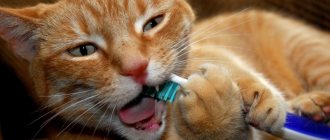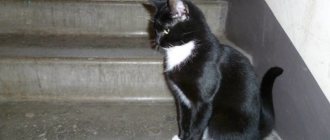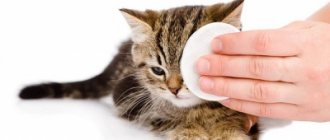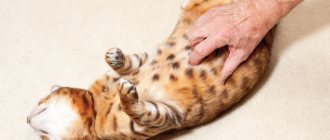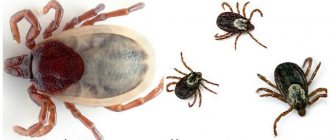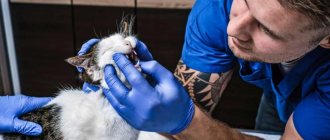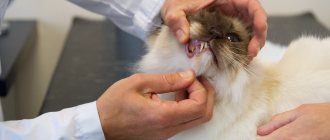What will you learn from the article?
- Does a cat need to brush its teeth?
- Why brush your cat's teeth?
- How to brush your cat's teeth How often should you brush?
- What you need for cleaning
- How to properly brush your cat's teeth at home
- At what age should cats be taught to brush their teeth?
- Alternative cleaning method
- Best Cleaning Products
Brushing your cat's teeth is the most effective way to reduce plaque, prevent tartar, and maintain long-term oral health. This procedure prevents many dental diseases and keeps the cat's breath fresh.
How to teach a kitten to brush its teeth? How correctly and how often should this be done? What means and tools should I use? You will find answers to all these questions in our article.
Do cats need to brush their teeth?
Is it possible to brush a cat's teeth? Need to! More than half of cats over 3 years old suffer from periodontal disease - inflammation of the tissues to which crowns are attached. It begins as gingivitis (inflammation of the gums) due to plaque accumulated on the teeth, where colonies of bacteria live. If plaque is not removed, tartar forms, creating a good environment for the development of microbes. In addition, the stone comes into contact with the gum, irritating it, causing inflammation. If the disease is neglected, the pet may lose teeth.
Other problems that may arise in cats if you decide that cats do not need to brush their teeth:
- caries;
- bleeding gums;
- bad breath;
- poor appetite;
- depressed mood;
- diseases of the digestive system due to putrefactive bacteria that came here from the oral cavity.
Of course, one could argue that wild cats have good teeth and don't need any cleaning. But their situation is different. They hunt and chew hard food, which allows them to clean the enamel of deposits. In addition, tough pieces of meat are less likely to get stuck in the teeth, while soft food, which is what indoor cats mostly eat, easily gets deposited between the crowns.
Which composition is safe for animals
Humans should not brush their teeth with toothpaste. After all, it cannot be swallowed, and it is impossible to explain this to a dog or cat. And the paste itself is tasteless, it stings the mucous membrane. Neither the cat nor the dog will definitely like it. The animal cannot rinse its mouth with water and spit the composition into the sink. Therefore, this composition is not suitable for a dog or cat. Moreover, such a paste is dangerous for them, because it contains xylitol and lauryl sulfate, which can be hazardous to the health of pets.
Special formulations are being developed for pets. This includes purified water, which dissolves solid particles. Titanium dioxide and sodium triphosphate remove bacterial plaque. Sodium bicarbonate whitens teeth; enzymes dissolve food debris between teeth.
In order for the paste to be stored for several months without losing its properties, preservatives are added to its composition: sodium benzoate and potassium sorbate. Sorbitol makes the product more pleasant to use. It also includes other flavorings: meat, liver, nuts, vanilla, milk, tomatoes.
It is good if the toothpaste contains natural additives, including parsley seeds, lavender, and tea tree oil. Purified clay makes toothpaste softer. It delicately cleanses the enamel of plaque without compromising the integrity of the enamel.
How to brush your cat's teeth at home
To clean your cat's mouth, use a pet toothbrush. On sale are:
- a toothbrush with curved handles to make it easier to handle the mouth;
- brushes that fit comfortably in your hand;
- fingertips – brushes that fit onto the finger.
If you don’t have one, a child’s, very soft toothbrush will do. If you are unsure whether the appliance can be used, make sure the bristles fall just below the gum line. As a last resort, you can use gauze wrapped around your finger or a cotton swab.
How to clean a cat's teeth?
In veterinary stores and pet pharmacies you can buy toothpaste for cleaning cats' teeth. They contain substances that are harmless to her and a smell that she will like.
Can toothpaste be used on humans?
Human pastes cannot be taken. They contain substances that should not be swallowed, and while a person can resist the reflex movement, a cat cannot. Swallowing the paste may cause digestive upset.
Can you use baking soda for cleaning?
No. Baking soda contains a lot of alkaline, which if swallowed can upset the acid balance in the stomachs. In addition, the pet may not like the taste of the product, and it will vomit during the procedure.
How to make a choice
Before starting to use a specific type or brand of toothpaste, it is best to consult with specialists. Some toothpastes have contraindications. A specialist will tell you which products are best suited for your beloved pet.
The choice of brush should also not be approached rashly. Human toothbrushes will not work. They are characterized by very long bristles and can injure the animal's gums. There are two types of special toothbrushes for cats: massage and bristly. It is advisable to use them alternately .
If cleaning is necessary for several cats at once, then the number of toothbrushes should correspond to their number. Toothpaste and brushes should be purchased only in specialized stores, or better yet, in a veterinary pharmacy.
How to properly brush your cat's teeth
The manipulation should be carried out according to the following scheme:
- Apply a dental gel to your brush to clean your cat's teeth.
- Position your pet's head at a 45-degree angle and gently lift its lips. You don't have to open the cat's mouth.
- Concentrate first on cleaning the large back teeth and canines, where plaque builds up most often.
- Proceed slowly and carefully. If the bristles touch your gums, it can cause irritation.
- Don't worry if your pet won't open his mouth or let you brush the tips and inside of his teeth. Most damage affects the outer part of the crowns, the periodontium. In addition, a cat's tongue is better than a human's at removing tongue from the inside of crowns, reducing the need for cleaning them.
- Gradually clean all crowns.
- The average cleaning time is 30-60 seconds. from each side.
Take your time during the procedure. Your pet's teeth should be brushed slowly and carefully so as not to scare the animal. Be sure to praise him.
How to brush a cat's teeth with a fingertip
If you don’t have a brush, you can clean the cat’s mouth with a fingertip using the same method. Before starting the procedure, train the cat to place the owner's finger in the pet's mouth. To do this, you can do a gentle massage of the gums, smearing your finger with food tasty for the cat, allowing it to be sniffed and licked.
What to look for when purchasing
When choosing a paste for your dog, pay attention to the following characteristics:
- The composition of the paste and its consistency. It should be homogeneous and free of lumps. If the paste is very liquid, it may have gone bad and cannot be used;
- Manufacturer. If it is a well-known company, then the chances of counterfeiting are minimal. And it can be dangerous for your pet;
- You should not buy products for future use so that they do not remain unopened until the expiration date. You can see it on the packaging. It itself should be intact, and the tube should be tightly closed;
- Toothpaste for dogs and cats should not foam. But it can be of different shapes. This can be a regular paste, gel, or hard tablets that the dog must chew diligently.
How to teach a kitten to brush its teeth
It is easiest to accustom a small kitten to the procedure. If the cat is an adult, the process may take longer. At first it will not be easy, but then the pet will get used to cleaning and will not pay attention to it.
To teach your kitten to brush, do this:
- Find a quiet, peaceful place where you can place your kitten. It is better to start training when the pet is on your lap, but you can put it on the table after laying down a towel. Make sure the door can be closed to block any escape route.
- Dip a cotton swab into the tuna liquid. Cats love the taste and it provides a good association with brushing their teeth.
- Raise the kitten's lips; you don't have to open your teeth.
- Rub the cotton swab onto your lips and the edges of your gums.
- The first few times, it is better to use a cotton swab to wipe a couple of crowns rather than all of them, especially if the kitten is unsure and nervous.
- When your pet gets used to the procedure, you can start using the brush.
Professional teeth cleaning for cats
Veterinarians recommend bringing your pet to the clinic once a year to evaluate the condition of the oral cavity. If the doctor detects inflammation or other problems with the gums, he will prescribe a medicine that will stop the disease in time.
Stones: what to do?
A timely examination by a veterinarian will help to detect and remove stones in time. If it forms, immediately go to the dentist. Remedies that offer to remove stones at home are ineffective. They can only prevent its occurrence, while solid formations must be removed by a specialist.
Cleaning stones on the teeth of cats can be done both with and without anesthesia. The second option is possible only if the pet behaves calmly and obediently opens its mouth.
In most cases, ultrasonic cleaning of cats' teeth is used. The procedure is expensive, but does not damage the enamel. Ultrasonic cleaning of a cat's teeth is carried out under anesthesia, since the cat may be frightened by the buzzing device or splashing water.
Before anesthesia, the doctor must carefully examine the pet and take tests to determine how it will tolerate the injection. This is especially important for kittens and older pets. The wrong dose can kill.
Caries: what to do?
Caries must be treated. Even if it doesn’t cause problems for your pet at first, sooner or later rotting will affect the roots, and then trouble will begin. Treatment of caries provides 2 options - crown removal and filling. The first is widespread, the second is possible only in advanced clinics and is expensive.
How to maintain oral hygiene other than brushing?
There are special dry foods on sale for cleaning cats' teeth. They contain substances that prevent the appearance of stones. They also have a structure that allows mechanical cleaning of crowns.
You can buy treats for cats to clean their teeth, which your pets will happily chew on. Cat dental cleaning pads have a hard surface that cleans the canines. Their active components destroy plaque and kill bacteria.
For teeth, there are commercially available oral fluids. They have cleansing effects and eliminate unpleasant odors. You just need to add them to your drink. Manufacturers assure that the drug for cleaning teeth in cats is safe and does not affect the functioning of the digestive tract. As for users, opinions vary. Some helped, others had no effect, and others experienced vomiting and diarrhea.
Toothpaste
The solution to the problem of oral and dental hygiene is quite simple - timely care and the use of toothpaste, which can not only gently clean the teeth of your beloved pet, but also eliminate the causes of caries, protect the gums from irritation, and help get rid of unpleasant odors.
This is achieved by destroying microorganisms that accumulate in the mouth and mechanically cleaning the oral cavity of any food debris.
IMPORTANT! Toothpaste for a cat is not the same toothpaste that we use to brush our teeth in the morning; it is very different in its chemical composition. In addition, most types of toothpastes used by humans containing fluoride are very toxic for animals.
Composition and other features
Toothpastes have now been developed that taste like meat, liver, and even fish. This greatly simplifies the cleaning procedure, since any cat likes such flavor solutions. There are mint flavored pastes that have a refreshing effect.
Sometimes you can't brush your pet's teeth with standard toothpaste. Then you need to use a liquid toothpaste for animals that has neither taste nor odor, which is the easiest to use and, when added to a drinking bowl, has the same effect as a standard toothpaste for cats.
In addition, there is a range of other products: special pads, tooth powder, rinses, which are also used to strengthen and cleanse teeth.
Cat paste may contain bone meal. In addition, they contain glycerin, triphosphate, carageenan and some important enzymes. Each paste designed for cleaning and getting rid of tartar has its own unique specific composition . Among the brands producing cat toothpaste, the most famous are Beaphar, Trixie, and Cliny.
Tips for cleaning your cat's mouth
- There are a lot of bacteria in a cat's mouth, so wear gloves during the procedure. If you cannot manipulate them, wash your hands thoroughly after finishing work.
- After the procedure, wash your toothbrush thoroughly.
- Change your cat's toothbrush every three months.
- If you have several pets, buy a separate cat hygiene product for each pet.
- Provide your cat with quality food. It has a good effect on the condition of teeth, making them resistant to decay.
- Before brushing, let your pet smell a sample of the paste. If he likes the smell, he will be more accommodating.
- Be sure to praise the cat during the procedure.
- If you can’t regularly remove plaque, buy treats - pads, teeth cleaning sticks for cats - by looking through the pet supplies catalog.
Useful tips
- There are a lot of bacteria in the animal's mouth, so it is recommended to wear gloves when brushing teeth;
- The toothbrush should be washed thoroughly after the procedure;
- The brush needs to be replaced every 3 months;
- If there are several cats in the house, then each one requires a separate brush;
- Animal feed must be of high quality;
- Before cleaning, you need to let the cat smell the paste;
- The procedure should be accompanied by praise.
If it is not possible to remove plaque regularly, then you can buy special treats - sticks, pads for cleaning cats' teeth.

